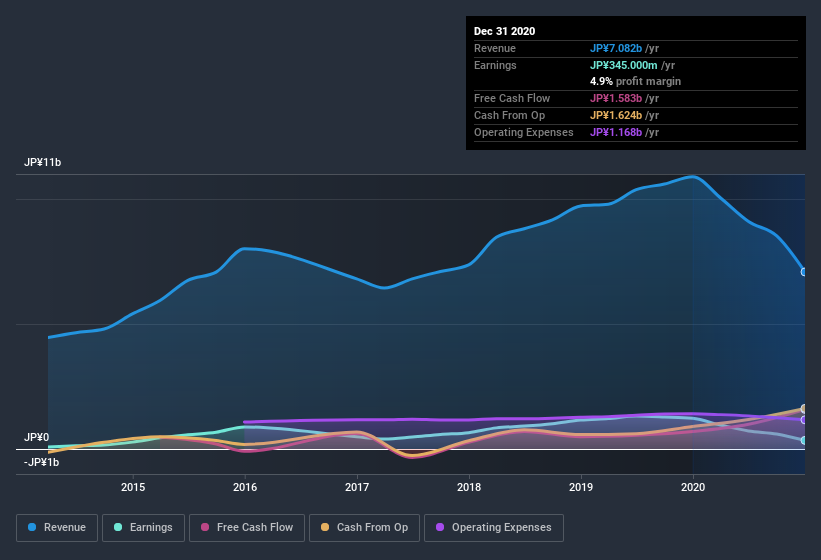We Think Taiyo Koki's (TYO:6164) Statutory Profit Might Understate Its Earnings Potential

Broadly speaking, profitable businesses are less risky than unprofitable ones. That said, the current statutory profit is not always a good guide to a company's underlying profitability. In this article, we'll look at how useful this year's statutory profit is, when analysing Taiyo Koki (TYO:6164).
It's good to see that over the last twelve months Taiyo Koki made a profit of JP¥345.0m on revenue of JP¥7.08b. In the last few years both its revenue and its profit have fallen, as you can see in the chart below.
Check out our latest analysis for Taiyo Koki

Importantly, statutory profits are not always the best tool for understanding a company's true earnings power, so it's well worth examining profits in a little more detail. Today, we'll discuss Taiyo Koki's free cashflow relative to its earnings, and consider what that tells us about the company. Note: we always recommend investors check balance sheet strength. Click here to be taken to our balance sheet analysis of Taiyo Koki.
A Closer Look At Taiyo Koki's Earnings
One key financial ratio used to measure how well a company converts its profit to free cash flow (FCF) is the accrual ratio. To get the accrual ratio we first subtract FCF from profit for a period, and then divide that number by the average operating assets for the period. The ratio shows us how much a company's profit exceeds its FCF.
That means a negative accrual ratio is a good thing, because it shows that the company is bringing in more free cash flow than its profit would suggest. While having an accrual ratio above zero is of little concern, we do think it's worth noting when a company has a relatively high accrual ratio. To quote a 2014 paper by Lewellen and Resutek, "firms with higher accruals tend to be less profitable in the future".
Taiyo Koki has an accrual ratio of -0.29 for the year to December 2020. Therefore, its statutory earnings were very significantly less than its free cashflow. To wit, it produced free cash flow of JP¥1.6b during the period, dwarfing its reported profit of JP¥345.0m. Taiyo Koki shareholders are no doubt pleased that free cash flow improved over the last twelve months.
Our Take On Taiyo Koki's Profit Performance
Happily for shareholders, Taiyo Koki produced plenty of free cash flow to back up its statutory profit numbers. Based on this observation, we consider it possible that Taiyo Koki's statutory profit actually understates its earnings potential! Unfortunately, though, its earnings per share actually fell back over the last year. At the end of the day, it's essential to consider more than just the factors above, if you want to understand the company properly. If you want to do dive deeper into Taiyo Koki, you'd also look into what risks it is currently facing. In terms of investment risks, we've identified 3 warning signs with Taiyo Koki, and understanding them should be part of your investment process.
Today we've zoomed in on a single data point to better understand the nature of Taiyo Koki's profit. But there is always more to discover if you are capable of focussing your mind on minutiae. Some people consider a high return on equity to be a good sign of a quality business. While it might take a little research on your behalf, you may find this free collection of companies boasting high return on equity, or this list of stocks that insiders are buying to be useful.
When trading Taiyo Koki or any other investment, use the platform considered by many to be the Professional's Gateway to the Worlds Market, Interactive Brokers. You get the lowest-cost* trading on stocks, options, futures, forex, bonds and funds worldwide from a single integrated account. Promoted
Valuation is complex, but we're here to simplify it.
Discover if Taiyo Koki might be undervalued or overvalued with our detailed analysis, featuring fair value estimates, potential risks, dividends, insider trades, and its financial condition.
Access Free AnalysisThis article by Simply Wall St is general in nature. It does not constitute a recommendation to buy or sell any stock, and does not take account of your objectives, or your financial situation. We aim to bring you long-term focused analysis driven by fundamental data. Note that our analysis may not factor in the latest price-sensitive company announcements or qualitative material. Simply Wall St has no position in any stocks mentioned.
*Interactive Brokers Rated Lowest Cost Broker by StockBrokers.com Annual Online Review 2020
Have feedback on this article? Concerned about the content? Get in touch with us directly. Alternatively, email editorial-team (at) simplywallst.com.
About TSE:6164
Taiyo Koki
Develops, manufactures, and sells grinding machine tools in Japan and internationally.
Flawless balance sheet and slightly overvalued.
Similar Companies
Market Insights
Community Narratives




